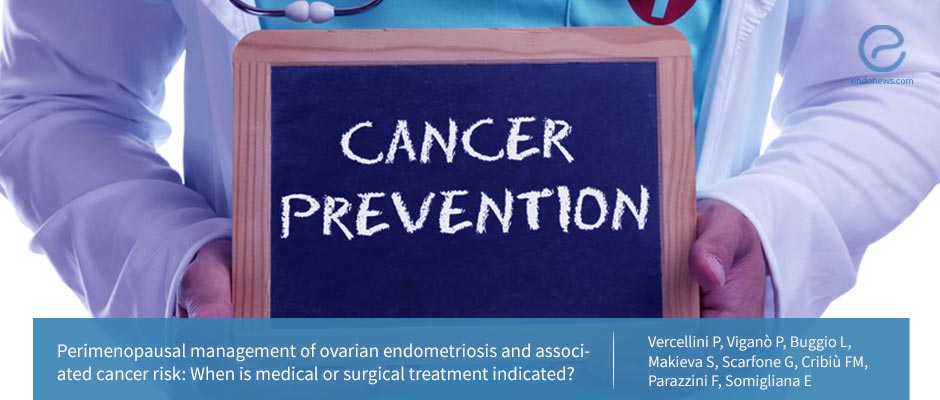Managing of endometriosis and associated ovarian cancer risk
May 24, 2018
Surgical and medical endometriosis treatment plans to reduce the ovarian cancer risk
Key Points
Highlight:
- Women with endometriosis have an increase in lifetime risk of ovarian cancer from 1.4% to about 1.9%.
- The risk of certain subtypes of ovarian cancer, namely the clear cell and endometrioid ovarian cancer is tripled and doubled, respectively.
- The overall risk is also associated with age and the dimension of the endometriotic cyst.
Importance:
- Due to the increased risk ovarian cancer risk, it is important to understand best management plan for ovarian endometriosis patients, whether through medical or surgical interventions, in order to prevent the development of endometriosis-associated cancer
What's done here:
This review article has two main discussion points:
- The management plan for perimenopausal patients with ovarian endometriomas.
- The benefit of prevention innervations to reduce mortality of ovarian cancer related to endometriosis in perimenopausal women with a history of endometriosis but without current endometriomas.
Data:
- Women with endometriosis and had prolonged oral contraceptive use is associated with a reduction in ovarian cancer risk.
- Management plan including surveillance with/without progestogen treatment or surgery should be communicated with perimenopausal women with small and typical endometriomas.
- Surveillance instead of risk-reducing bilateral salpingo-oophorectomy is advisable for perimenopausal women with a history of endometriosis but without endometriomas. Evidence of benefit for risk-reducing salpingo-oophorectomy is inconclusive. In women with endometriosis history without ultrasonographic evidence of endometriomas, surveillance seems advisable.
- Patients may feel better assisted from risk profiling models and decision aids.
- In women with small, typical endometriomas, bilateral salpingectomy and removal of the ovaries can be considered when approaching the menopause.
- Screening approaches to detect asymptomatic endometriomas in perimenopausal population is unlikely to reduce associated mortality.
Lay Summary
According to a number of studies, endometriosis is associated with moderate increase in ovarian cancer risk. This risk is elevated in subjects with a long-standing history of untreated ovarian endometriosis. Endometriosis is particularly associated with risk for certain histological subtypes of ovarian cancer including the clear cell and endometrioid ovarian cancer. Clear cell ovarian cancer prevalence is dependent on geographic area. It has a higher prevalence in Asian regions, particularly Japan (15-25%), as compared to 1-13% reported in Europe and North America.
This article by Vercellini et al. published in Best Practice & Research Clinical Obstetrics and Gynaecology from Infertility Unit, Fondazione IRCCS Ca’ Granda e Ospedale Maggiore Policlinico, and Universita degli Studi, Milano, Italy discussed management plan and benefit of medical or surgical prevention of endometriosis-associated ovarian cancer. Perimenopause describes a period in a women life from 1 year following final menses and 2-8 years preceding menopause. The main objectives of this review are to discuss (i) management plan for perimenopausal patients with ovarian endometriomas and (ii) to deduce the benefit of prevention interventions in perimenopausal women with a history of endometriosis but without current endometriomas.
A number of important points regarding management plan to reduce the risk of ovarian cancer in endometriosis are highlighted below. (i) Atypical endometriosis excised in premenopausal women with endometriomas may represent the intermediate precursor lesion associating endometriosis and clear cell/endometrioid tumors; (ii) Oral contraceptive use for greater than 10 years can reduce ovarian cancer risk with endometriosis; (iii) In perimenopausal women with typical endometriomas, surveillance with and without progestogen treatment and surgery should be discussed as management plan; (iv) Surgical procedure if chosen in women who do not want future conception should include removal of affected ovaries together with bilateral salpingectomy, rather than cystectomy alone. This is especially important in the case of long-standing or recurrent endometriomas. (v) In perimenopausal women with previous endometriosis but without endometriomas, surveillance instead of risk-reducing bilateral salpingo-oophorectomy should be considered; (vi) Risk-profiling models and decision aids may be useful in assisting patients with available treatment choices. However, population screening of asymptomatic endometriomas is unlikely to reduce endometriosis-related cancer mortality.
Research Source: https://www.ncbi.nlm.nih.gov/pubmed/29551389
ovarian cancer risk treatment management

